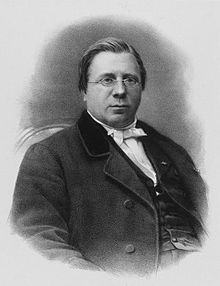Pierre Ossian Bonnet
Pierre Ossian Bonnet (born December 22, 1819 in Montpellier , † June 22, 1892 in Paris ) was a French mathematician and professor at the Sorbonne in Paris.
Bonnet studied from 1838 at the École polytechnique and then at the École des Ponts et des Chaussées in Paris. Instead of an engineer, however, he became a mathematician. He taught privately and published mathematical work on series - one earned him a prize from the Brussels Academy of Sciences in 1849. He began his work on differential geometry in 1844. In the same year he was a tutor at the École polytechnique. In 1862 he was elected to the French Académie des Sciences as successor to Jean-Baptiste Biot , mainly because of his work on differential geometry . In 1868 he became assistant (suppléant) to Michel Chasles at the École polytechnique in his lectures on higher geometry and in 1871 Directeur d´Études. In addition, he also taught at the École normal supérieure . Bonnet introduced numerous improvements in mathematics teaching at the two elite universities. Not least because of this, he became Professor of Astronomy at the Sorbonne in 1878 as the successor to Urbain Le Verrier . In 1877 he was elected a corresponding member of the Göttingen Academy of Sciences . In 1883 he became a member of the Bureau des Longitudes as the successor to Joseph Liouville .
He provided fundamental work on differential geometry. This was founded in particular by Leonhard Euler , Gaspard Monge and Carl Friedrich Gauß (in a fundamental treatise from 1827), but due to the lack of a systematic treatment and many unanswered questions, it offered itself as a field of research, which in the 1840s by a number of French Mathematician (besides Bonnet among others Joseph Serret , Jean Frédéric Frenet ) was taken up. He introduced the Bonnetian plane coordinates, examined minimal surfaces and geodetic lines on surfaces of positive curvature. Based on these investigations, the Bonnet theorem was named after him. The Gauss-Bonnet theorem that specifies a formula for the surface curvature, was discovered by Carl Friedrich Gauss, who in his treatise of 1827 just published a special case, and Bonnet. Independently of Ferdinand Minding, he showed the invariance of geodetic curvature in surface bends. Also of importance is his contribution to an 1859 Academy Award assignment to find all surfaces for a given line element, for which Edmond Bour (1832–1866) (whose name the problem is sometimes associated with) and Delfino Codazzi submitted award papers (Bour won the price). In addition, Bonnet also dealt with mathematical physics, mechanics and cartography.
Collected works by Bonnet did not appear, but his contributions to differential geometry are presented in the textbook by Gaston Darboux Leçons sur la théorie générale des surfaces (4 volumes, Paris, 1887–1896).
He was married and had three sons.
literature
- Dirk Struik , Article Bonnet, Pierre-Ossian in Dictionary of Scientific Biography
- Paul Appell : Notice sur la vie et les travaux de Pierre Ossian Bonnet, Comptes rendus de l 'Académie des Sciences, Volume 117, 1893, pp. 1013-1024
Web links
- John J. O'Connor, Edmund F. Robertson : Pierre Ossian Bonnet. In: MacTutor History of Mathematics archive .
- Biography of Heyerhoff
- H. Laurent, Pierre-Ossian BONNET (1819-1892), Livre du Centenaire de l'Ecole polytechnique, 1897 (French)
Individual evidence
- ^ Bonnet, Sur quelques proprietes générales des surfaces et des lignes tracées sur les surfaces, Comptes rendus de l'Académie des Sciences, Volume 14, 1844. He introduces geodetic curvature and torsion.
- ↑ Holger Krahnke: The members of the Academy of Sciences in Göttingen 1751-2001 (= Treatises of the Academy of Sciences in Göttingen, Philological-Historical Class. Volume 3, Vol. 246 = Treatises of the Academy of Sciences in Göttingen, Mathematical-Physical Class. Episode 3, vol. 50). Vandenhoeck & Ruprecht, Göttingen 2001, ISBN 3-525-82516-1 , p. 45.
- ↑ Bonnet, Mémoire sur la théorie générale des surfaces, Journal de l'École Polytechnique, Volume 32, 1848, pp. 1-46
- ↑ Bonnet, Mémoire sur la théorie des surfaces applicables sur une surface donnée, Journal de l'École Polytechnique, Volume 41, 1865, pp. 201-230, Volume 42, 1867, pp. 1-151
| personal data | |
|---|---|
| SURNAME | Bonnet, Pierre Ossian |
| BRIEF DESCRIPTION | French mathematician and university professor |
| DATE OF BIRTH | December 22, 1819 |
| PLACE OF BIRTH | Montpellier |
| DATE OF DEATH | June 22, 1892 |
| Place of death | Paris |
